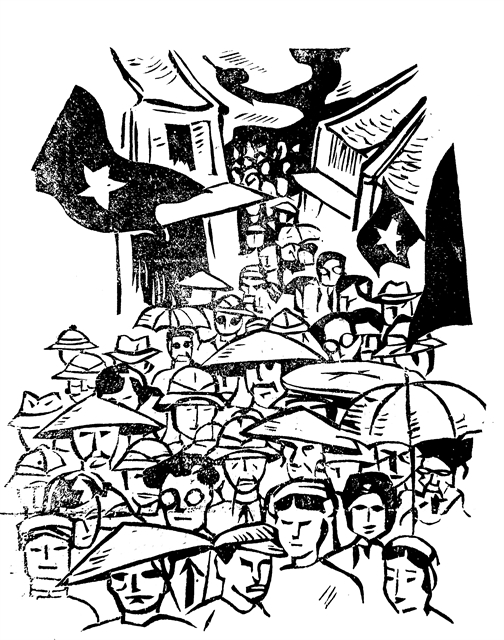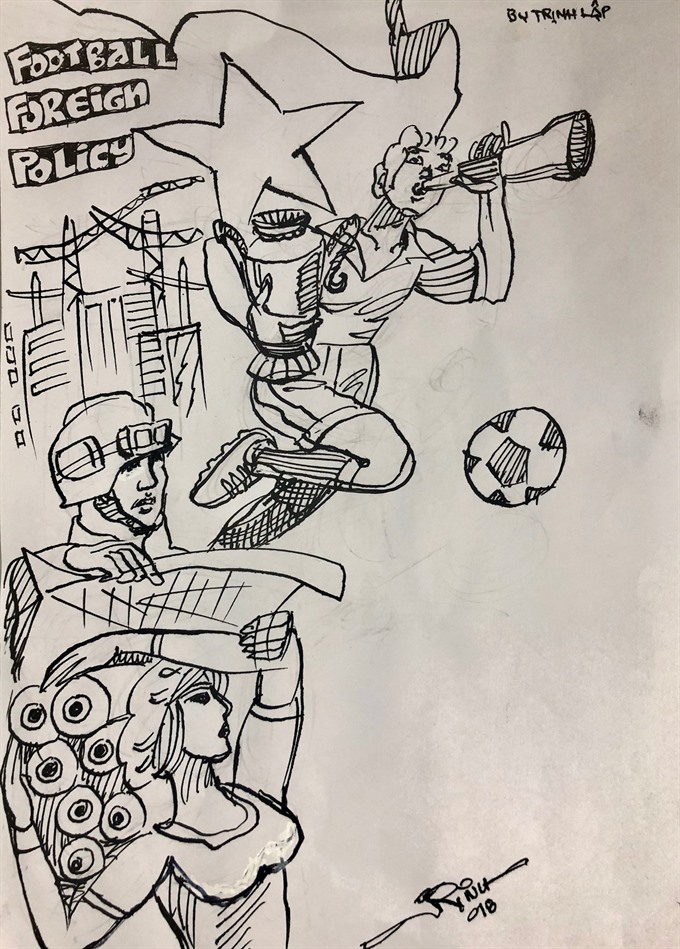 Talk Around Town
Talk Around Town

Amid the football frenzy that captured Việt Nam last Saturday, I had a question no one was able to answer solidly: How many people actually went out onto the street to celebrate the AFF Suzuki Cup victory of the Việt Nam team?
 |
| Illustration by Trịnh Lập |
by Nguyễn Mỹ Hà
In this digital age of the internet and social media, you can grasp what’s on trend and what’s hot at the touch of a button: how many views and comments does a Facebook post get, how many likes and shares does it attract.
Amid the football frenzy that captured Việt Nam last Saturday, I had a question no one was able to answer solidly: How many people actually went out onto the street to celebrate the AFF Suzuki Cup victory of the Việt Nam team?
Counting the crowd could be classed as a basic skill required for a reporter. Novice reporters may get the first assignments reporting on a fire, a traffic accident, a large street demonstration or a concert.
The first tools one can use is to count with your own eyes, which is good if the event has less than a hundred people gathering in one place. Relying on information provided by organisers can be tricky, because, according to experts, the numbers can be exaggerated for PR purposes.
Others suggest you can estimate the crowd applying a square to it, estimate the sides and the percentage of people filling it, but first you need to be in a high position to get a bird’s-eye view.
Another useful tool can be the Jacobs Crowd Formula, named after Herbert Jacobs, a journalism professor in the 1960s, who came up with the idea watching students protesting the Vietnam War from his window. His basic density rule says a light crowd has one person per 10 square feet, and a “dense crowd” has one person per 4.5 square feet (4.1 square metre). A heavily dense crowd would have one person per 2.5 square feet, which means there are ten people for every square metre.
Aerial photos and fly cam pictures can be used to count heads in a crowd as well. Some computer tools will help you count better as higher resolution helps you see more heads, and gridlines help you divide the photo into squares to make it easier to count.
Even if you could count the heads in a photo, you would also have to factor in other sources, such as from the police, security forces and/or the organisers.
You can also use the one-point method to pick a position close to the main point of a march or parade and count the number of people passing by in a given amount of time.
The Watson and Yip method uses two counting stations to measure the number of people passing by one station and check with them if they also pass the other station to rule out those who are counted twice.
The last resort can be turned into computer-assisted and web-based tools. An online company offers a service to count heads for a fee.
All of the above mentioned methods can be used only if people walk on foot and gather or move at a walking pace to a designated point.
But the Saturday parade had people riding on motorbikes, two, three or even four members of a family onboard, riding through the streets of Điện Biên, Thái Nguyên, Hà Nội, Hải Phòng, Nam Định, Thanh Hóa, Huế, Đà Nẵng, Quy Nhơn, Nha Trang, Hồ Chí Minh City, and Cần Thơ.
How can web-based tools help capture all the motorized red-flagged currents moving in all the cities and towns at the same time and at night?
It’s impossible to get a correct answer.
While Reuters reporters estimated the number to be hundreds of thousands people taking to the streets, it is arguable that it could be much lower than the actual number.
On my street, with the flow of motorbikes and minivans with people passing by, a large number of onlookers just stood on the pavements waving at them.
Closer to the city centre, the streets became jammed with vehicles.
If you live in a big city in Việt Nam, it’s likely you’ve been stuck in a traffic jam more than once and felt frustrated.
But in that crowd, people did not feel frustrated. They felt a strong positive flow of energy exuberating from everyone around.
Some people, reluctant to share or join in the celebrations, posted some irate statuses on their Facebook accounts. Some asked if it was just a crazy spree that had nothing to do with sport or football. Some asked if it was an expression of patriotism that had largely gone silent during daily life, but now had a chance to come out in full force?
“Đi bão”, meaning storming the street, has become a widely popular term.
A red tide of sheer joy and open patriotism embraced all cities and even smaller communities across the country.
The next morning, everything was back to normal. No more flag waving, no more gold-starred red shirts, all the cars and vans with the cups and stickers of the national team and their coach had returned to their original colours.
Nothing left of the frenzy that took place the previous night.
Like in a dream, the joy lasted for only a few hours.
People with a more critical mind started to ask how we could turn the festive mood into a more fruitful flow of activities and how to retain that joy over a longer period of time.
Branding expert Lại Tiến Mạnh spoke on national television about building a brand for the team, making it a national asset. As a result, the Việt Nam Football Federation (VFF) will become its brand manager.
“If we agree on this point of view, which sets a core pretext, we can then talk about how to use the brand and for what purpose,” he said.
He further elaborated that the team’s brand must be used for grander purposes to enhance the profit the VFF is getting now.
Tourism advertising, attracting foreign investment and even country image branding can be associated with its national football team, which directly leads to the Football Foreign Policy.
Even before this can be implemented, Park Hang-seo, the team’s coach from South Korea, has already voted Man of the Year by Korea’s Journalists Association. In 2017, President Moon Jae-in announced his New Southern Policy, which sought closer and stronger ties with ASEAN countries. Among ASEAN countries, mutual trade between South Korea and Việt Nam accounts for more than 40 per cent.
The first steps of a Football Foreign Policy have been made. VNS




